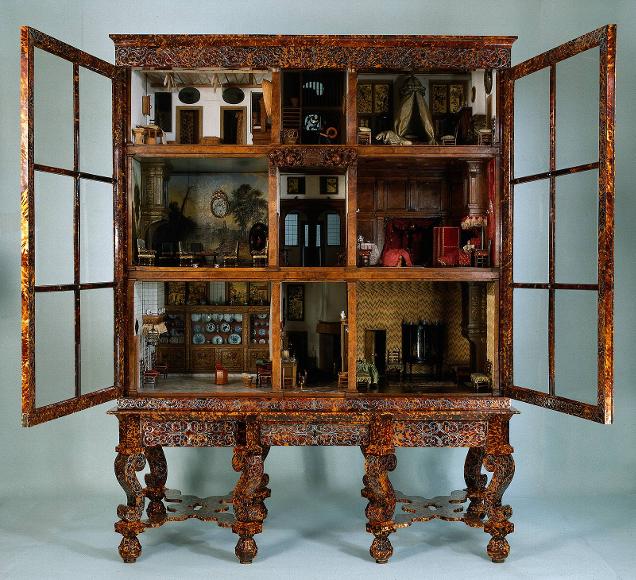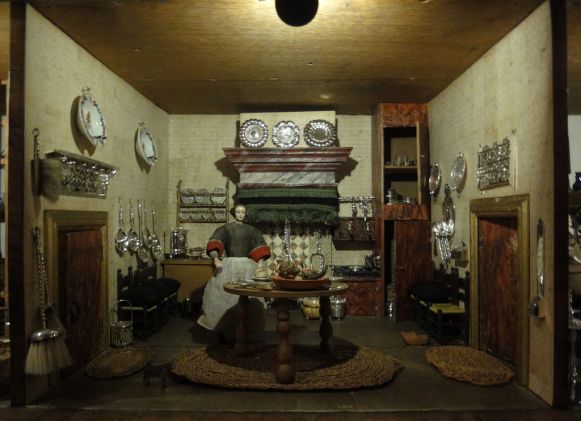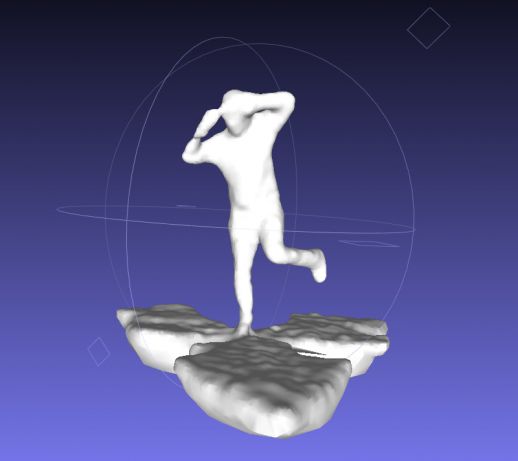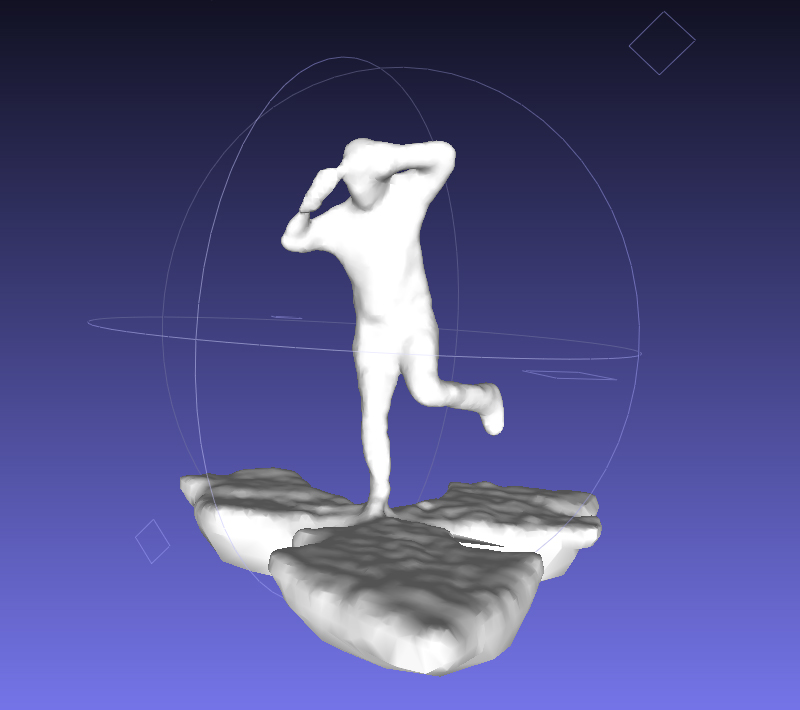Miniature
From imagination in miniature to the miniature as new media object.
Fabbing the Miniature
Before the rise of automation in the 18th and 19th century, the
miniature was a completely handmade. It was a symbol of wealth and
nostalgia, and it was the challenge of the artist to make the miniature
as resembling as possible toward its original, with all its rich
details. In many cases the originals where the furniture, and other
interior objects. Dutch miniatures of the time were often exact
reproductions of the owner’s household furnishing.(note) In the 20th
century with the integration of plastics in productions chains, and a
new (Ford-ian) revolution in production methods, toys and miniatures
became more and more mechanized. But still there is the real miniature
of which its value was defined by the nostalgic artesian creation
process from the beginning of assembly to the finishing touches (1). The
well-known models of airplanes, cars, (navy) ships and so on. The
hobbyist buys a cardboard box with a photo of the original on the top,
and at home in the attic an intensive minute creation process starts.


Today most design processes moved to the 3D space of the computer.
Before it reaches the production line the model had intensive process of
digital modeling and shaping. The actual model evolves in the realm of
endless flexibility, numerical information, and scalelessness. In his
entertaining book ‘Shaping Things’ Bruce Sterling introduces the reader
into the world of SPIMES. Sterling describes the evolution of the
(consumer) object from (handmade) artifacts, to machines (complex
assemblages, with moving parts, tapped on non human-animal-power), to
gizmos (unstable, multifeatured objects, commonly programmable, with a
short lifespan, connected to networks), ending with SPIMES (material
instantiations of an immaterial system, begin and end as data).(2)
“After a while, once I’m used to this new routine, I don’t even think
of my model as ‘the model’ any more. My model has become the central
part of the creative effort. The modeling arena is where I shape my
things. The physical object is merely a hard copy. In a SPIME world, the
model is the entity, and everyone knows it” (3)
Every physical object in the SPIME world has its 3D generated model.
And objects that weren’t fabricated based on a 3D model, will get one.
By scanning the object and digitize it into its ‘original’ 3D model.
The SPIME world of Bruce Sterling is a world of tangible appearances of
digital objects and images. A world of materialized new media objects.
Installation by blablabLAB, Barcelona, January 2011. In this
installtion the public is scanned with a 3D scanner, and printed as a
souvenir. In fact exactly the same technique I am using, both not for a
joyful souvenir.
A first 3D scan of myself. Test set-up with 3 Kinects, point cloud exported to Meshlab to generate a mesh.
Today regularly visitors of the Fablabs (Organized network of open
fabricator-labs around the world. Groningen also has one.) are hobbyist
miniature makers and young designers. Old retired engineers utilizing
their AutoCad (One of the first professional, technical 2D/3D design
software applications) skills and creating 3D model parts for their
train model miniatures. Young interior architects, printing miniature
prototypes of their designs for clients and presentations. The miniature
today has no physical original like in the 17th century, but is
materialized result of a digital creation process. And if a trace of a
physical original is found, it’s always after the reversed engineering
process of digitalization. The miniature as a new media object.
The Doll's House of Petronella Oortman, 1686-1705, Collection of the
RijksMuseum Amsterdam, It was commissioned by Petronella Oortman, a
wealthy Amsterdam lady. The house is remarkable in that all of the
components are made exactly to scale. Petronella ordered miniature
porcelain objects from China and commissioned furniture makers and
artists to decorate the interior.
notes:
(1) Susan Stewart, On Longing: Narratives of the Miniature, the
Gigantic, the Souvenir, the Collection, Duke University Press 1993,
Tableau: The Miniature described, page 58
(2) Bruce Sterling, Shaping Things, MIT Press 2005, page 11
(3) Ibid., page 96
photo's and video's:
The Doll House of Petronella Oortman,
https://www.rijksmuseum.nl/aria/aria_assets/BK-NM-1010?page=1&lang=en&context_space=&context_id=
Close Dutch Doll House, http://www.flickr.com/photos/jimforest/4432786325
blablabLAB, Be your own Souvenir, https://vimeo.com/21676294
CLose-up of a room in one of two 18th century doll houses that is on permanent exhibition at the RijksMuseum in Amsterdam.
Maybe my interest in the ‘tangible’ miniature has something to do with
the shift towards the digital. Not only in my process, but also in the
world of objects. My roots are in sculpture. The first three years of
art school I created my sculptures with clay, plaster, wood, stone, and
metal. An intensive communication process in which I used physical force
to project my thoughts and intuition on matter. A one on one fight with
matter. The last time a hard drive crashed (two years ago, without any
backup) I realized that I lost a world of immaterialized (art)works.
All ideas stored as numeral data, without having the chance to take
shape or to exist in the physical world…gone!! Most of these ideas and
sketches were the result of an intensive communication process in which I
used physical force to move my mouse and project my thoughts and
intuitions on the screen. An object that emits light!!!
Its no option to go back and start sculpturing again. You and your
work simply evolve during the years. My work evolved and shifted in the
direction of new media. That’s what inspires me, irritates me, and keeps
me going. Experimenting with miniatures in my work, feels like
re-introducing matter in a process shifted too much towards the
immaterial, the digital. A physical miniature as instant proof for
something that exists digitally.
The miniatures used for the Speech were created from train model
material and miniature figures. The scale is very small and the
miniatures are, for their scale, highly detailed. Their colors resemble
physical reality. The miniatures printed with the 3D printer will be
imperfect, single colored, and will have less detail. They are a result
of the imperfect transformation from medium to medium. With this
transformation I would like to expose the invisible, not always
consciously experienced, shift towards the digital and the way it
influences our perception of reality. Producing an instant, mutilated,
physical proof (as a corpse) of this transformation, shows the loss of
reality caused by the distortion and compression that characterize
digitalization.
Many artists use the miniature to address universal themes about live,
youth, aging, mortality, catastrophe and cruelty. They use the
imaginational and narrative capacities of the miniature to visualize
these themes, and involve the spectator. The reason why I want to
reconstruct a catastrophe is exactly because of this. Use the mutilated
material instantiations of the bodies of the spectators, to tell a story
about mortality and death, about the physical vs the digital, about
flesh and blood.
My Miniature
back






